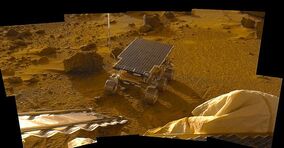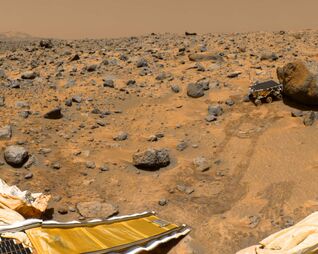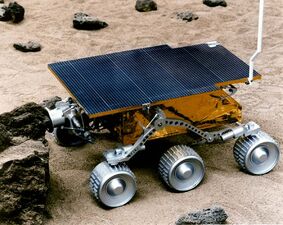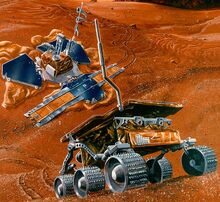
A sojourner is a person who resides temporarily in a place, which is ironic as Sojourner travelled a distance of just over 100 metres (330 ft) by the time communication was lost.
Sojourner was the Mars Pathfinder robotic Mars rover that landed on July 4, 1997 in the Ares Valles region, and explored Mars for around three months. It has front and rear cameras and hardware to conduct several scientific experiments. Designed for a mission lasting 7 sols, with possible extension to 30 sols, it was in fact active for 83 sols. The base station had its last communication session with Earth at 3:23 a.m. Pacific Daylight Time on September 27, 1997. The rover needed the base station to communicate with Earth, despite still functioning at the time communications ended. It was instructed to stay stationary until October 5, 1997 (sol 91) and then drive around the lander.
Rover operations[]

Pathfinder's picture of Sojourner.
Sojourner deployment[]
The Sojourner rover exit from the lander occurred on Sol 2, after its landing on July 4, 1997. As the next sols progressed it approached some rocks, which the scientists named "Barnacle Bill", "Yogi", and "Scooby-Doo", after famous cartoon characters. The rover made measurements of the elements found in those rocks and in the martian soil, while the lander took pictures of the Sojourner and the surrounding terrain, in addition to making climate observations.
The Sojourner is a six-wheeled 65 cm long vehicle, 48 cm wide, 30 cm tall and weighing 10.5 kg. Its maximum speed reached one centimetre per second. Sojourner travelled approximately 100 metres in total, never more than 12 m from the Pathfinder station. During its 83 sols of operation, it sent 550 photographs to Earth and analysed the chemical properties of 16 locations near the lander.
Sojourner's rock analysis[]
The first analysis on a rock started on Sol 3 with Barnacle Bill. The Alpha Particle X-ray Spectrometer (APXS) was used to determine its composition, the spectrometer taking ten hours to make a full scan of the sample. It found all the elements except hydrogen, which constitutes just 0.1 percent of the rock's or soil's mass.
The APXS works by irradiating rocks and soil samples with alpha particles (helium nuclei, which consist of two protons and two neutrons). The results indicated that "Barnacle Bill" is much like Earth's andesites, confirming past volcanic activity. The discovery of andesites shows that some Martian rocks have been remelted and reprocessed. On Earth, Andesite forms when magma sits in pockets of rock while some of the iron and magnesium settle out. Consequently, the final rock contains less iron and magnesiums and more silica. Volcanic rocks are usually classified by comparing the relative amount of alkalis (Na2O and K2O) with the amount of silica (SiO2). Andesite is different from the rocks found in meteorites that have come from Mars.
Analysis of the Yogi rock again using the APXS showed that it was a basaltic rock, more primitive than Barnacle Bill. Yogi's shape and texture show that it was probably deposited there by a flood.
Another rock, named Moe, was found to have certain marks on its surface, demonstrating erosion caused by the wind. Most rocks analysed showed a high content of silicon. In another region known as Rock Garden, Sojourner encountered crescent moon-shaped dunes, which are similar to crescentic dunes on Earth.

By the time that final results of the mission were described in a series of articles in the journal Science (December 5, 1997), it was believed that the rock Yogi contained a coating of dust, but was similar to the rock Barnacle Bill. Calculations suggest that the two rocks contain mostly the minerals orthopyroxene (magnesium-iron silicate), feldspars (aluminum silicates of potassium, sodium, and calcium), quartz (silicon dioxide), with smaller amounts of magnetite, ilmenite, iron sulfide, and calcium phosphate.
On-board computer[]
The embedded computer on board the Sojourner rover was based around the 2 MHz Intel 80C85 CPU with 512 KB of RAM and 176 KB of flash memory solid-state storage, running a cyclic executive.
The computer of the Pathfinder lander was a Radiation Hardened IBM Risc 6000 Single Chip (Rad6000 SC) CPU with 128 MB of RAM and 6 MB of EEPROM and its operating system was VxWorks.
The mission was jeopardised by a concurrent software bug in the lander, which had been found in preflight testing but was deemed a glitch and therefore given a low priority as it only occurred in certain unanticipated heavy-load conditions, and the focus was on verifying the entry and landing code. The problem, which was reproduced and corrected from Earth using a laboratory duplicate thanks to the logging and debugging functionality enabled in the flight software, was due to computer resets caused by priority inversion. No scientific or engineering data was lost after a computer reset, but all the following operations were interrupted until the next day. Four resets occurred (on July 5, 10, 11 and 14) during the mission, before patching the software on July 21 to enable priority inheritance.
Naming the rover[]

An artist's rendering of Sojourner and Pathfinder.
The name Sojourner was chosen for the Mars Pathfinder rover after a year-long, worldwide competition in which students up to 18 years old were invited to select a heroine and submit an essay about her historical accomplishments. The students were asked to address in their essays how a planetary rover named for their heroine would translate these accomplishments to the Martian environment.
Initiated in March 1994 by The Planetary Society of Pasadena, California, in cooperation with NASA's Jet Propulsion Laboratory (JPL), the contest got under way with an announcement in the January 1995 issue of the National Science Teachers Association's magazine Science and Children, circulated to 20,000 teachers and schools across the nation.
The winning essay, which suggested naming the rover for Sojourner Truth (1797-1883) abolitionist and women's rights activist, was selected from among 3,500 essays and was submitted by 12-year-old Valerie Ambroise of Bridgeport, CT. First runner-up was Deepti Rohatgi, 18, of Rockville, MD, who suggested Marie Curie. Second runner-up was Adam Sheedy, 15, of Round Rock, TX, who submitted the name of the late astronaut Judith Resnik, who perished in the 1986 Challenger space shuttle explosion. Other popular suggestions included Sacajewea and Amelia Earhart.
Honors[]
- In 1997, the Sojourner Team was awarded a JPL Award for Technical Excellence.
- On October 21, 1997, at the Geological Society of America's annual meeting in Salt Lake City, Utah, Sojourner was awarded honorary membership in the Planetary Geology Division of the society.
- In 2003, Sojourner was inducted into the Robot Hall of Fame.
